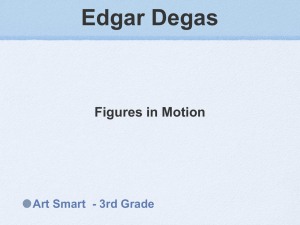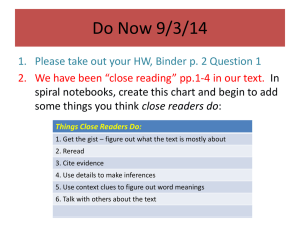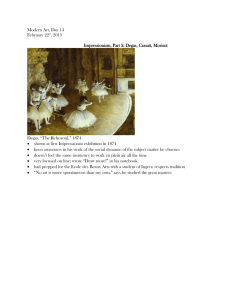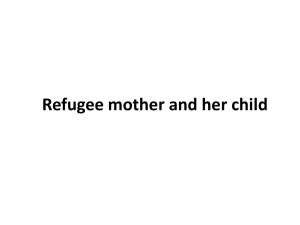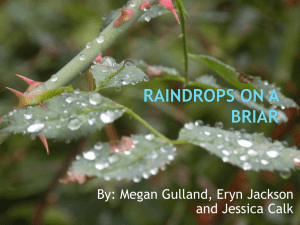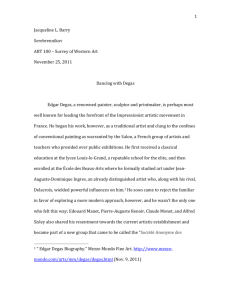Degas*s Laundresses
advertisement
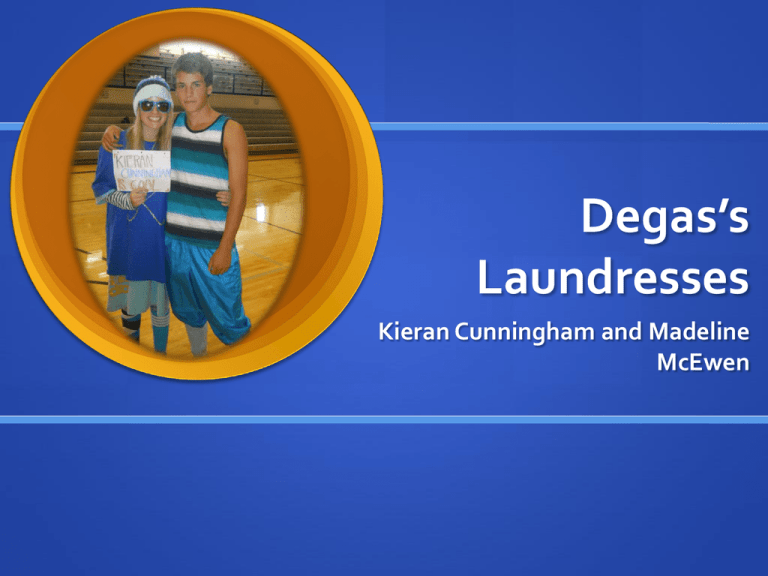
Degas’s Laundresses Kieran Cunningham and Madeline McEwen You rise, you dawn roll-sleeved Aphrodites, out of a camisole brine, a linen pit of stitches, away from you like waves. You seam dreams in the folds of wash from which freshes the whiff and reach of fields where it bleached and stiffened. Your chat’s sabbatical: brides, wedding outfits, a pleasure of leisured women are sweated into the folds, the neat heaps of linen. Now the drag of the clasp. Your wrists basket your waist You round to the square weight. Wait. There behind you. A man. There behind you. Whatever you do don’t turn. Why is he watching you? Whatever you do don’t turn. Whatever you do don’t turn. See he takes his ease staking his easel so, slowly sharpening charcoal, closing his eyes just so, slowly smiling as if so slowly he is unbandaging his mind. Surely a good laundress would understand its twists, its white turns, its blind designs-- it’s your winding sheet. Vocabulary Aphrodite- goddess of love and beauty Camisole- a short negligee jacket for women (www.merriam-webster.com) Brine- water saturated or strongly impregnated with common salt Sabbatical-a break or change from a normal routine Clasp- A fastening, such as a hook or buckle, used to hold two or more objects or parts together Inarguables Context: Similar to other poems: 7 stanzas Written in second person narrative This poem is about the painting by Edgar Degas, “Laundresses carrying linen in town” Boland believes that art is restricting life- “I think there is a very real way in which art can fix and restrict life” Speaker: Boland herself or 3rd person narrator she created for the purpose of this poem Audience: The laundresses in the painting The speaker speaks directly to them in stanza 4 Arguables Key points She is pointing out that Degas’ poem has a clichéd, stereotypical way of portraying women. Boland is warning the laundresses of the painter and how he is invading their privacy by exposing a moment of lighthearted innocence to scrutiny. Most pivotal lines “staking his easel so, slowly sharpening charcoal” Portrays Degas as threatening (preparing weapons) The last line of the poem Shows this by mood (see literary features) Thank god it’s over Most puzzling lines “Whatever you do don’t turn.” in stanza 4 If she feels that it is a negative portrayal of women to be subservient and defenseless and have stereotypical roles, wouldn’t she want them to turn around and see the man who is using them, for what he is? Literary Features Allusion to clichéd portrayal of women: Aphrodite Word Choice: using words that elicit a sense of smell, making the painting seem more alive. (connecting to Boland’s negativity toward the way art restricts life) Word choice: shows her view that the painting shows a stereotypical view of women’s role in life Seamstresses, washerwomen, defenseless, subservient Ominous/Foreboding Mood: Using sense of time in the 5th stanza to show suspense, making it seem like the painter is being invasive and invading the privacy of the laundresses. Boland contributes to the foreboding mood, like something bad is going to happen, with her staccato rhythm in the 4th stanza. This accentuates the literal meaning of the words. Bibliography "Eavan Boland's Feminist View of a Degas Painting, Page 2 of 4." Associated Content from Yahoo! Associatedcontent.com. Web. 06 Nov. 2011. <http://www.associatedcontent.com/article/40271/eavan_ bolands_feminist_view_of_a_degas_pg2.html?cat=38>. My dad

